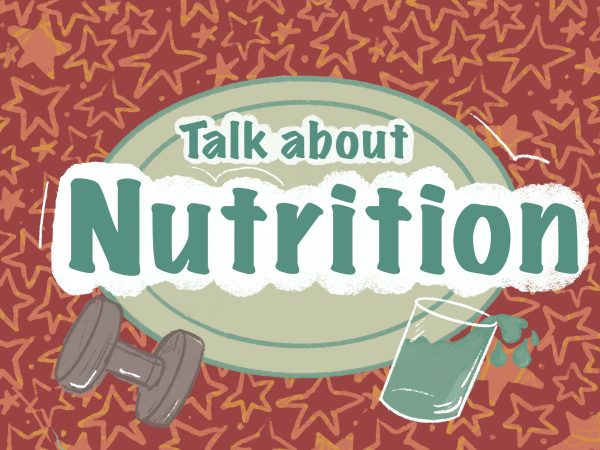Trigger warning: this article contains content discussing eating disorders.
To seek help, contact the Suicide and Crisis Lifeline: 988 or text Crisis Text line: “HOME” to 741-741.
Additional resources can be found here.
While nutrition for female athletes is something that has not received very much attention, some sports teams like Dos Pueblos High School’s girls cross country team have made efforts to ensure that nutrition is something they prioritize.
This year, girls cross country captains, Quinn Gleason (12), Eloise Shea (12), and Cate Bishop (11), shared a presentation with their freshman runners in an effort to educate them about the importance of nutrition.

“It was mainly Eloise and I who made [the presentation],” Gleason said. “We actually made it last year, but we never got around to presenting it.”
Many female athletes feel pressure to not only find success within their sport, but to also maintain a body image or weight that conforms to societal standards of conventional attractiveness. A large part of this issue stems from what is known as diet culture.

Diet culture is the practice of participating in diets, specifically focussed on weight loss, in order to fit in with society’s image of a “perfect body.” The belief that being thin is equivalent to a healthy lifestyle is a myth, as someone’s body composition, shape, and weight often do not reflect their health.
Body image dissatisfaction driven by diet culture can be detrimental to athletes both mentally and physically. This dissatisfaction can contribute to the development of eating disorders like anorexia nervosa and bulimia nervosa. While disordered eating can affect any athlete, it is especially prevalent among female athletes, with up to 45 percent of female athletes experiencing eating disorders, according to the National Eating Disorders Association.
While creating their presentation, Shea and Gleason took inspiration from their captains from the years prior, who had instilled a similar message in them.
“So my freshman year, the three female captains immediately would talk to us, do a little discussion about eating enough, and they told us their personal experiences with not eating enough and how it affected them,” Bishop said. “And so from the very first run with them … I’ve always been aware of it, and as a team we just carried on that tradition.”
Gleason explained how the previous years’ captains had emphasized two main points: the importance of both being “positive about your body” and “making sure that you’re eating a lot” while doing cross country training. One of the captains’ main goals with their presentation was to pass down this message.
“We’re just hoping to start a tradition that will pass on to the next year’s captains … so that it’s just as a whole a positive environment that’s healthy,” Shea said.
For athletes, optimal nutrition can allow for enhanced performance, which is why the nutritional aspect of athletics is so important and must be stressed. Medline plus states that, in order for athletes to compete with adequate energy levels and be able to build and repair muscles, they need to consume sufficient quantities of carbohydrates, protein, and fluids.
The slideshow created by the captains highlighted several different aspects of nutrition and health.
“It was a Google Slides presentation with multiple slides, kind of showing … how you should eat a lot, how carbs are good, how really you … should be more hungry now that you’re running cross country,” Gleason said. “And also on top of that, just like overall health, of making sure you’re sleeping, drinking, listening to your own body, and knowing that this is your body and if a coach tells you to do something, it’s ultimately up to you to decide and do what you know is best for yourself.”
The presentation additionally emphasized the importance of maintaining your period as a female athlete. According to Mayo Clinic, factors like over-exercising, under-fueling, or disordered eating can all lead to irregularities or the complete loss of an athletes’ period. Missing periods can be a sign of underlying health issues, making it essential for female athletes to track their cycles and be aware of any changes.
“Each slide was about a different part of nutrition,” Bishop said. “One was about having and maintaining your period, which was, I believe, a really important one.”
There are numerous protective factors that can be implemented into athletics to effectively combat the harmful effects of diet culture, and DPHS’s girls cross country captains have made sure to nurture a positive environment where open communication about these issues can be had.
“Sometimes when you’re on a big team, like cross country, you feel like, ‘Oh I’m having these issues or these concerns, but … I think I’m the only one’ or ‘I don’t know how to speak up,’” Shea said. “So we just wanted to hopefully make it a more open conversation, so that they could come to us and talk to us.”
While anyone can develop an eating disorder, athletes who do endurance sports (like cross country, cycling, or swim) or sports that focus on the individual (like gymnastics, figure skating, or dance) have been found to develop an eating disorder more often than other athletes.
“It is also a very hard sport, because you’re just surrounded by very small girls, so I’ve always felt the internal pressure,” Bishop said. “Everyone, I believe, does struggle with being a runner and female, because there’s so many runners at the start line, just smaller than you.”
Bishop acknowledged that “underfueling” is an experience that many other girls who do sports struggle with. Other runners on the girls cross country team shared similar experiences as Bishop.
“Running is one of those sports where there’s, like, the societal want for a certain appearance to run faster,” Ila Walman-Randall (11) said. “So it’s just important to me, when I’m running, to keep my body weight and, if not, gain weight, because I’m still growing, and then … make sure I still have a healthy body image.”
DPHS girls cross country athlete, Vienza Machuca (11), expressed how the team has put an emphasis on nutrition in an effort to “maximize athletic performance,” along with addressing the societal expectations put on women’s bodies.
“Especially as a female athlete, I feel like it’s … very ideal to have a super lean athletic body, which is just kind of unrealistic when it comes to high school girls, because we’re still developing,” Machuca said. “And what you see on social media is like … weighing less is running faster, that kind of misconception.”
Being able to reject diet culture beliefs is something that is important for the well being of athletes and their performance.
“I think in society, sometimes it can be seen [that] girls shouldn’t eat that much, but obviously that’s not true,” Gleason said. “So it’s important … to make sure we set a precedent where [the girls] know that they should be comfortable eating and being positive about themselves.”










